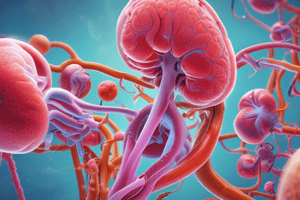Podcast
Questions and Answers
What is the most common cause of drug-induced acute interstitial nephritis (AIN)?
What is the most common cause of drug-induced acute interstitial nephritis (AIN)?
- Proton pump inhibitors (PPIs) (correct)
- Beta blockers
- Angiotensin-converting enzyme (ACE) inhibitors
- Non-steroidal anti-inflammatory drugs (NSAIDs)
What is a common clinical feature of acute interstitial nephritis (AIN)?
What is a common clinical feature of acute interstitial nephritis (AIN)?
- Hematuria
- Renal impairment (correct)
- Proteinuria
- Hypertension
What may be present in some patients with drug-induced acute interstitial nephritis (AIN)?
What may be present in some patients with drug-induced acute interstitial nephritis (AIN)?
- Signs of a generalised drug hypersensitivity reaction (correct)
- Signs of a generalised bacterial infection
- Signs of a generalised allergic reaction
- Signs of a generalised viral infection
What is a possible complication of acute interstitial nephritis (AIN)?
What is a possible complication of acute interstitial nephritis (AIN)?
What is a possible laboratory finding in some patients with drug-induced acute interstitial nephritis (AIN)?
What is a possible laboratory finding in some patients with drug-induced acute interstitial nephritis (AIN)?
What percentage of patients are likely to have eosinophils?
What percentage of patients are likely to have eosinophils?
What can be said about the presence of eosinophils in patients?
What can be said about the presence of eosinophils in patients?
What is the significance of eosinophils in patients?
What is the significance of eosinophils in patients?
In what percentage of patients are eosinophils absent?
In what percentage of patients are eosinophils absent?
What can be inferred about the presence of eosinophils in patients?
What can be inferred about the presence of eosinophils in patients?
What is the potential source of nephrotoxicity associated with herbal medicines in Asia?
What is the potential source of nephrotoxicity associated with herbal medicines in Asia?
Which populations are affected by Balkan nephropathy?
Which populations are affected by Balkan nephropathy?
What is the possible route of exposure to nephrotoxic substances in Balkan nephropathy?
What is the possible route of exposure to nephrotoxic substances in Balkan nephropathy?
What is the geographic distribution of Balkan nephropathy?
What is the geographic distribution of Balkan nephropathy?
What is the likely cause of nephrotoxicity associated with herbal medicines in Asia?
What is the likely cause of nephrotoxicity associated with herbal medicines in Asia?
What may underlie many cases of CIN?
What may underlie many cases of CIN?
Which plant has been associated with CIN due to toxin presence?
Which plant has been associated with CIN due to toxin presence?
What is a potential risk factor for developing CIN?
What is a potential risk factor for developing CIN?
What is a possible underlying cause of CIN, according to research?
What is a possible underlying cause of CIN, according to research?
What is a potential source of toxins linked to CIN?
What is a potential source of toxins linked to CIN?
What is a characteristic feature of salt-losing nephropathy?
What is a characteristic feature of salt-losing nephropathy?
Which of the following is NOT a feature of sodium and water depletion?
Which of the following is NOT a feature of sodium and water depletion?
What is the primary cause of polyuria in salt-losing nephropathy?
What is the primary cause of polyuria in salt-losing nephropathy?
Which of the following laboratory findings is LEAST likely to be associated with salt-losing nephropathy?
Which of the following laboratory findings is LEAST likely to be associated with salt-losing nephropathy?
What is the underlying pathophysiologic mechanism of salt-losing nephropathy?
What is the underlying pathophysiologic mechanism of salt-losing nephropathy?
Flashcards are hidden until you start studying





